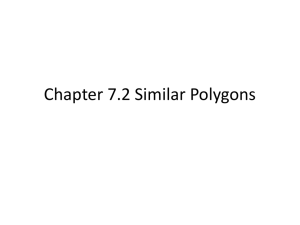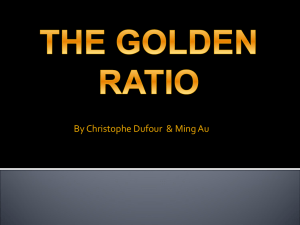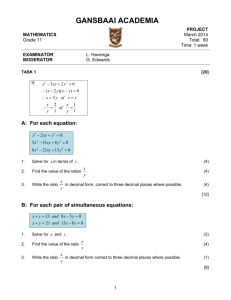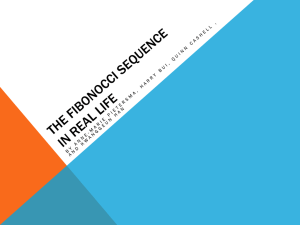Literature Review
advertisement
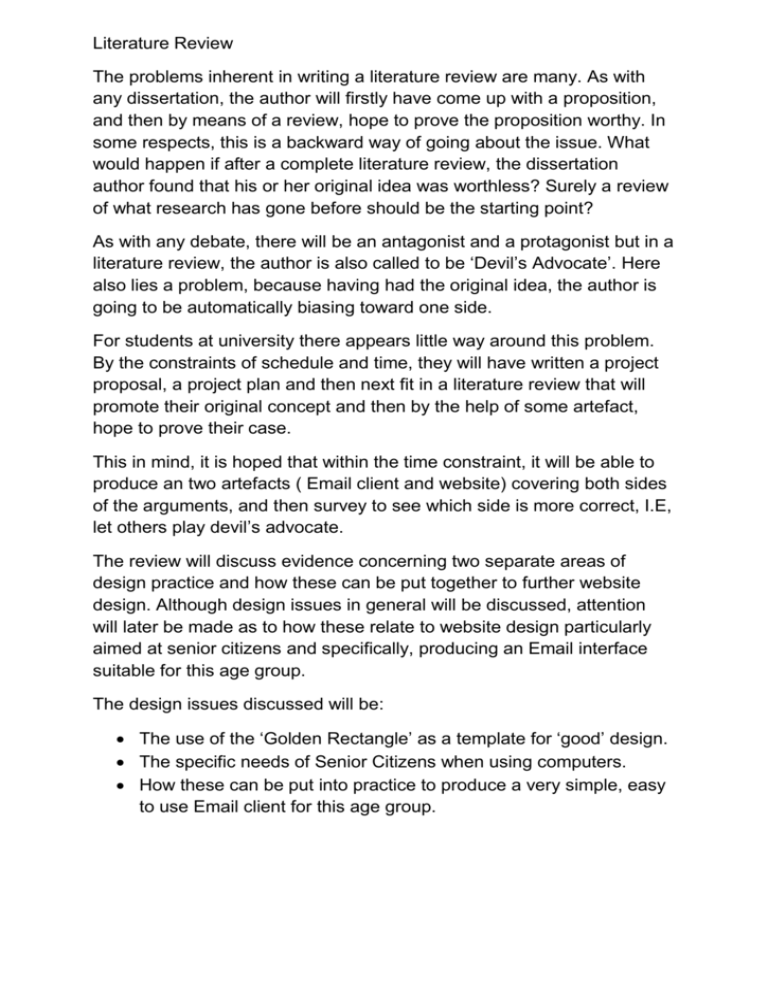
Literature Review The problems inherent in writing a literature review are many. As with any dissertation, the author will firstly have come up with a proposition, and then by means of a review, hope to prove the proposition worthy. In some respects, this is a backward way of going about the issue. What would happen if after a complete literature review, the dissertation author found that his or her original idea was worthless? Surely a review of what research has gone before should be the starting point? As with any debate, there will be an antagonist and a protagonist but in a literature review, the author is also called to be ‘Devil’s Advocate’. Here also lies a problem, because having had the original idea, the author is going to be automatically biasing toward one side. For students at university there appears little way around this problem. By the constraints of schedule and time, they will have written a project proposal, a project plan and then next fit in a literature review that will promote their original concept and then by the help of some artefact, hope to prove their case. This in mind, it is hoped that within the time constraint, it will be able to produce an two artefacts ( Email client and website) covering both sides of the arguments, and then survey to see which side is more correct, I.E, let others play devil’s advocate. The review will discuss evidence concerning two separate areas of design practice and how these can be put together to further website design. Although design issues in general will be discussed, attention will later be made as to how these relate to website design particularly aimed at senior citizens and specifically, producing an Email interface suitable for this age group. The design issues discussed will be: The use of the ‘Golden Rectangle’ as a template for ‘good’ design. The specific needs of Senior Citizens when using computers. How these can be put into practice to produce a very simple, easy to use Email client for this age group. The Golden Rectangle Around 300BC, Euclid of Alexandria, a venerated mathematician considered an equation in his book ‘The Elements’ that he described as ‘extreme and mean rectangle’. His definition is: A straight line is said to have been cut in extreme and mean rectangle when, as the whole line is to the greater segment, so is the greater to the lesser. In numerical rather than algebraic terms this is: 1:(one-to-phi); that is, 1:1.618. This equation became known as the ‘golden ratio, and later the ‘golden rectangle’ and is also used in defining the properties of the ‘golden triangle’. The equation is also sometimes referred to as ‘divine section, golden cut and mean of Phidias (or simply PHI). Whatever name is used the equation remains the same as above. Amazing also is the fact that when Leonardo Fibonacci (born around 1175 AD some 1500 years or so after Euclid) considered the sequence later named after him, it was clear that the sequence, each term in the sequence being the sum of the proceeding two (1:1:2:3:5:8:13 etc), closely followed the rules of the golden rectangle and that this became even more precise the higher into the sequence one considered. For the purposes of this review it will be referred to as the golden rectangle. This golden rectangle has many applications from the natural, such as the arrangement of leaves and sunflower seeds to the arrangement of aluminium alloy crystals to man-made items such as architecture, paintings and even predictive models concerning stock markets. One could assume that since this equation is ‘inbuilt’ into the above mentioned, as well as other later mentioned areas of life, then it should be proved as what we would call ‘good design’ or ‘best practice’ or ‘most aesthetic’. It could be argued that if one believes in god, or even if one believes in natural selection, then the prevalence of this equation throughout nature proves its aesthetic quality. But this is not actually the case. There are arguments both for and against this golden rectangle being considered an ‘acme’ design template. http://plus.maths.org/issue22/features/golden/feat.pdf In his paper 1997−2004, Millennium Mathematics Project, University of Cambridge. Mario Livio discusses how the artist Salvador Dali used the dimensions of the golden rectangle particularly when painting his ‘Last Supper’. There is no doubting that many and even most would consider this piece of art the work of a master, but Livio also points out that there are many ‘great’ pieces of art that depart from using such mathematics in their composition and so it is purely the preference of the artist and neither method has more merit aesthetically. Further backing up the proposal that the golden rectangle method of design is of no greater value is the opinion off H.R. Schiffman and D.J. Bobko that when experimenting on personal preferences to which rectangle size was more pleasing to the eye, there was no clear winner, especially not one that conformed to golden rectangle proportions. The Golden Ratio: A Contrary Viewpoint Clement Falbo The College Mathematics Journal Vol. 36, No. 2 (Mar., 2005), pp. 123-134 Published by: Mathematical Association of America Article Stable URL: http://www.jstor.org/stable/30044835 Fablo also takes the view that much literature concerning the golden rectangle is misleading at best and downright untrue at worst. After firstly explaining how the Fibonacci sequence is emphatically linked to the proportions of the golden rectangle he then goes on to say: ‘However, we should not expect the complexities of natural systems to yield to the easy-to-compute Fibonacci sequence, and there seems to be no unbiased evidence favouring the Fibonacci sequence over all other possible sequences. If one expends great effort in looking only for this special sequence, then it may be perceived, whether or not it is there’. There is a case however, that perhaps Fablo is here arguing against himself. ‘If one expends great effort in looking only for this special sequence, then it may be perceived, whether or not it is there’. Could this conclusion actually be adding fuel to the protagonists of the idea that appreciation of the golden triangle proportions is inherently a human condition? If we will eventually see this proportion whether it is there or not, then surely we ‘want’ to see it. If this is the case, why then do humans seem to still prefer the proportions of the golden rectangle? Where do the proportions exist in everyday life whether designed by mathematical calculation or by ‘eye’? The answer is in fact, everywhere. One only has to look around ones home to see that these proportions are very often used. The dimensions of most televisions, kettles, cupboards and so on and so forth, units in a kitchen all follow loosely, the golden rectangle proportions. It as if the human eye is tailored to appreciate this. The mere fact that some of the designs we see are not actually mathematically designed to be so, and are done so by ‘eye’ goes some way to proving that that the golden rectangle design is what most humans find aesthetic. It is an in-built view. This idea is confirmed by The Golden Section Emma C. Ackermann The American Mathematical Monthly Vol. 2, No. 9/10 (Sep. - Oct., 1895), pp. 260-264 Published by: Mathematical Association of America Article Stable URL: http://www.jstor.org/stable/2969272 Emma C. Ackermann in comparison to H.R. Schiffman and D.J. Bobko. She is of the opinion that many examples of the golden rectangle are to be found in nature and that where there is no equal division (symmetry) in art or manufacture, ‘the artist or workman unconsciously employs the proportions of the golden section’. The important point is that humans unconsciously employ the proportions. She also goes on to mention other everyday items that appear to closely follow the proportions of the golden rectangle such as tables, chairs, doors and others. Even in the very latest design, golden rectangle can be seen to be loosely followed. For example take the following three images that have had a golden rectangle overlaid on them: The above designs are amongst the most successful in their particular fields and whether by design choice or by accident, it is clear to see that the screens especially fit the dimensions of the golden rectangle. The images are especially relevant when discussing the third part of the review and how an Email client could be built using the golden rectangle proportions that is viewable on not just computer screens but a variety of other technologies.



